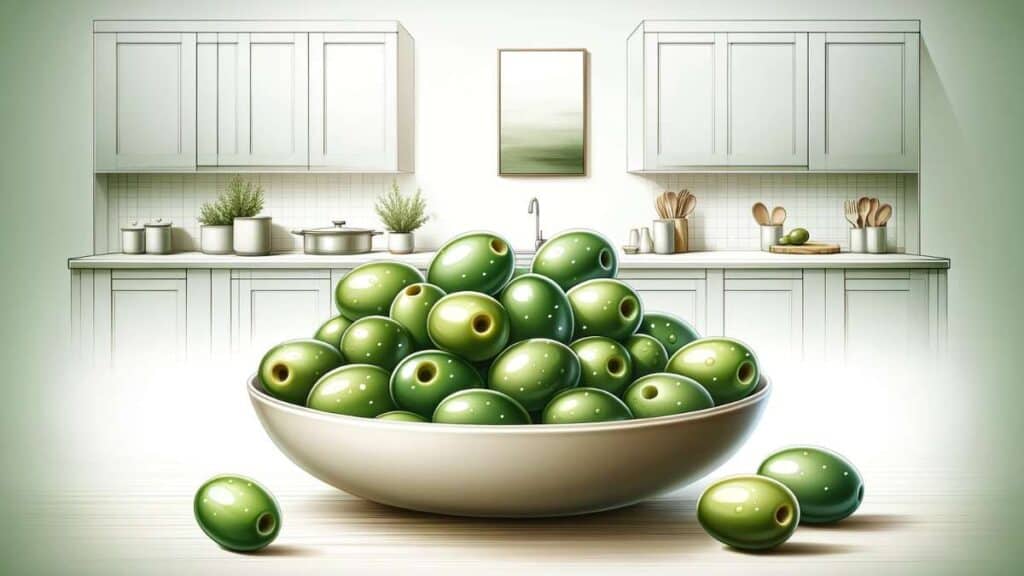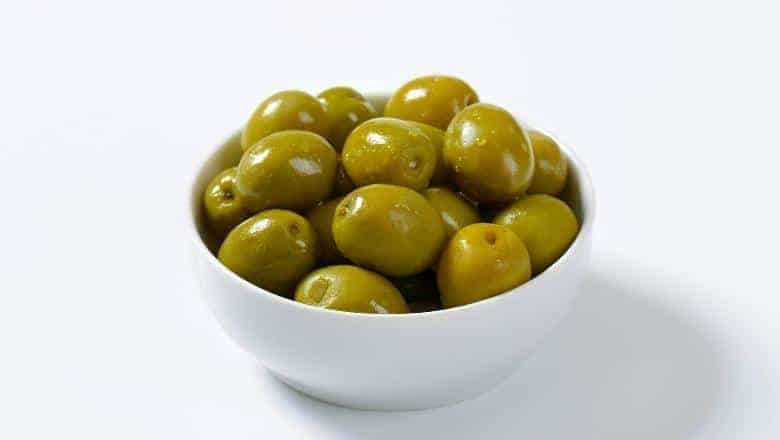Are Olives Still Good To Eat If They Have White Spots On Them?
Olive Knowledge is a part of Amazon Associates. As an Amazon Associate, we earn from qualifying purchases. Read our Affiliate Disclosure to learn more.
How many times have you bought a jar of brined olives, and after a week or two, you spot white stuff on the olives? It happens all the time to all of us. Honestly, in the past, I threw plenty of half-empty jars because of this problem. In this blog post, I’ll explain what are these white spots and how to get rid of them so you can enjoy your snack.
Key Takeaways:
- Usually, brined olives with white spots on them are eatable.
- If olives are still hard and don’t look rotten, it’s all right.
- You can remove those white spots (mold) by taking olives out of the brine, washing them in water, and pouring them into a new brine made with salty water.
- If olives look moldy and are soft, dispose of them.
Are Olives With White Spots Safe To Eat?

Brined or oil-cured olives are packed in plastic containers, open crocks, or glass jars. You can purchase them from many grocery stores and off the shelf from delicatessens or olive bars. If you find that your brined olives have white spots on them, don’t assume they’re unsafe to eat right away. The white spots may be mold, but they also could be harmless yeast deposits.
Mold grows when oxygen is present but doesn’t grow well in an environment rich in salt (in this case, brine). As long as you purchased your olives from a reputable source, they are edible with white spots.
However, if the olives are soft or mushy, you should discard them. Softness indicates spoilage, and spoilage of any kind means that the food shouldn’t be eaten anymore.
So, to conclude, if olives look okay and are still hard but have white spots on them, they are still fine and safe to eat. But if they’re very soft and look rotten, they’re spoiled.
What Are These White Spots?
Once you open the jar, the white spots usually start to appear. The reason is that the olives that were submerged in brine were not exposed to oxygen during storage. Once you open the jar and expose it to air, the oxidation process starts, which causes the white spots.
Olives with whitish spots can actually be one kind of mold, usually harmless, as long as the olives are hard and look and taste fine.
There’s a “bad” kind of mold that can grow on olives (or anything else) when they’re too soft. If your olives are soft and have black or green spots, throw them away!
In most situations, undangerous white spots may be removed from the olives, which I’ll explain to you below.
How To Get Rid Of White Spots

One way to get rid of white spots is to take a spoon, remove them, and eat those delicious olives. However, many people (including me) don’t like that option, and that’s why you should do it in another way.
The best way to remove white spots from brined olives is to take them out of the jar, thoroughly wash them in water, wash the jar, make a new brine, and return them back to the jar.
Here are the steps you should take:
- Take olives out of the jar.
- Wash them with warm water and then once again with cold water.
- Make sure all the white spots are gone.
- Pour all the brine from the jar.
- Thoroughly wash the jar with warm water.
- Put olives back into the jar.
- Make a salty water mix and pour it into the jar.
- Put 2-3 cloves of garlic into the jar.
- Close the jar, and you’re ready – olives are perfectly safe to eat again.
When it comes to salty water, a good ratio is 1/4 cup of salt per quart of water. And for the garlic, garlic also has some properties that’ll slow down the mold buildup – and may also add some great taste to brined olives.
Related: 4 Curing Methods For Olives
That way, you’ll save a few bucks since you won’t throw olives whenever you see a few white spots on them. I threw many jars in the past, and since I started using this technique, I always have enough time to eat all the olives from the jar.
Signs That Brined Olives Have Gone Bad
Olives are a fruit, and the white spots you see on the exterior of the olive are simply the result of air coming into contact with the olive itself and can be fixed by the method I showed you above.
However, to make sure that olives are still fine, check these signs, which will help you to determine whether olives are still good, or you should dispose of them.
Signs of spoiled brined olives:
- Changes in color – if green olives are becoming darker and browner, this is a sign of rottenness
- They’re very soft – very soft brined olives are usually rotten and spoiled
- Bad smell – if there’s a bad smell coming out when you open the jar, it’s a sign that the whole jar is spoiled, and you should throw it away
- Bad taste – if you try one olive and it tastes bad (something similar to soap or mold), they’re spoiled.
Those are the most important signs you should check for before eating out the whole jar of brined olives. Hopefully, you’ll always eat them before they become spoiled hehe.
Conclusion
Olives are fruits that grow on trees, and like other fruits, they can rot. When brined olives are spoiled, they usually have a bitter flavor with a pungent ammonia smell. The olives may also be dark in color and have a soft, mushy texture.
So, for the white spots on brined olives, in most cases, there’s nothing to worry about. If there are no other signs of rottenness, it’s just a harmless accumulation of mold that can be removed by following the tips I gave you above.
I hope that you’ll try the method that helped me to save a few bucks and to keep brined olives healthy and fresh for longer. Just make sure to keep the jar in the fridge.
Similar Articles For You:
